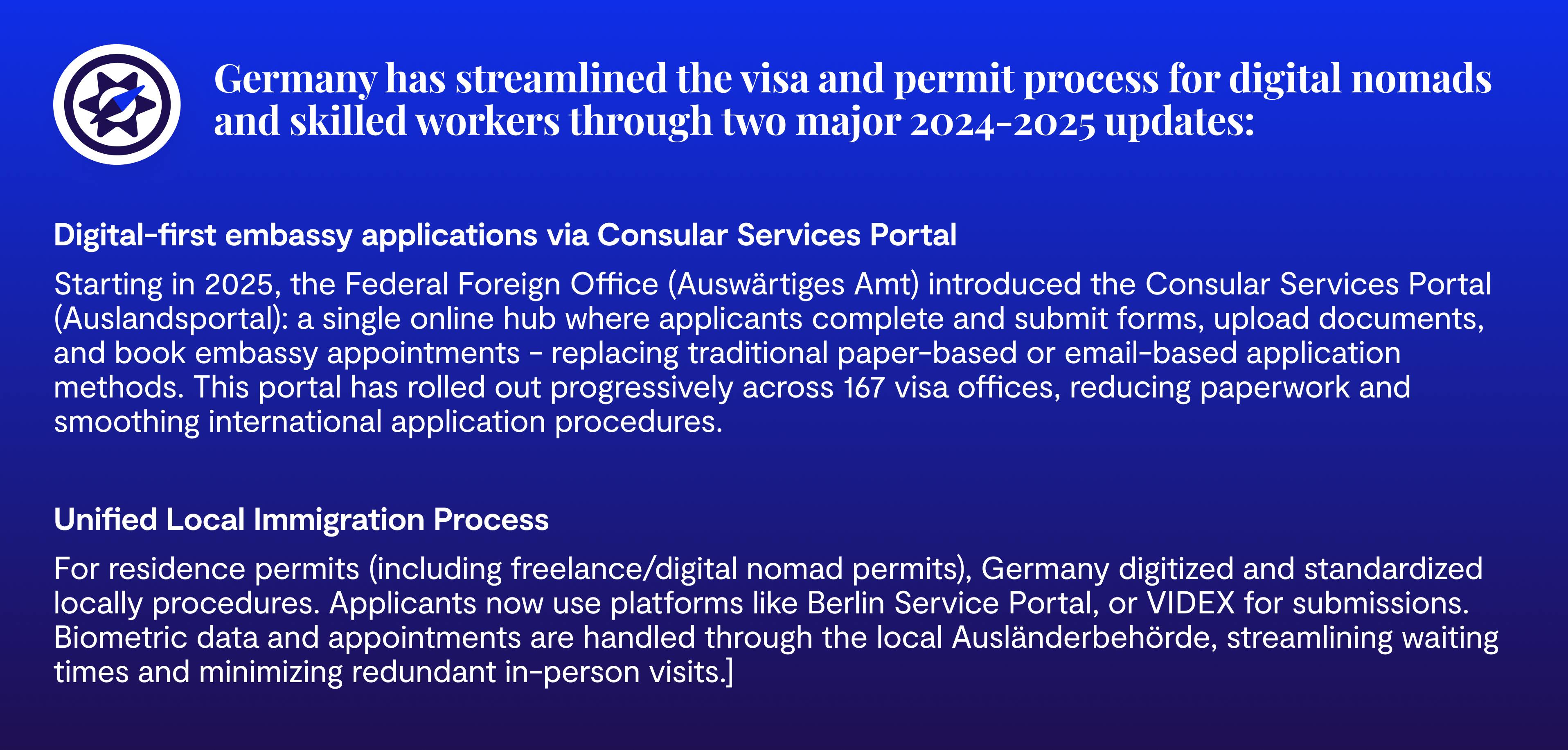In our previous blog on digital nomadism, we explored the 2024 landscape and identified key predictions that shaped global mobility in the year ahead. One year later, many of those trends not only came true - they accelerated. The digital nomad movement continued to expand across industries and borders in 2025, solidifying its role as a defining force in the future of work.
This quick report offers a data-driven look at the digital nomad experience in 2025, and a clear view of what to expect in 2026. From shifting demographics and rising global destinations to new visa policies and compliance challenges, here’s what’s changed, what’s trending, and what’s next.
2025 Digital Nomad Demographics
New data shows that digital nomadism continues to grow in 2025, particularly among professionals aged 30-39 and in tech-adjacent roles. Here are some key demographic insights:
- 49% are aged 30-39, 13% in their 20’s, 38% are 40+
- 61% are American; Canada, UK, and Brazil follow
- 26% of U.S. digital nomads travel with children
- 58% identify as male, 40% as female
- 71% are white, 15% are African American, 7% Asian
- 56% are Millennials; 27% Gen Z, 14% Gen X
- 55% live with a partner or are married
- 62% identify as non-religious
The 2026 profile: tech-literate, mid-career professionals from the U.S., often traveling with a partner or family.
Education & Employment
Digital nomads remain a highly educated cohort. In 2025:
- 52% held a bachelor’s degree
- 35% had a master’s degree
- 3% had a PhD
- Only 10% had no tertiary education (educated after completing High School/Secondary School).
Top job categories included:
- Software & web development
- Digital marketing & SEO
- UX/UI design & product Management
- Writing, translation, and virtual assistance
- Data analytics & cybersecurity
This highly educated cohort tends to cluster in roles that support remote-first productivity and digital innovation.
Satisfaction, Earnings and Job Types
According to sources, job satisfaction:
- 84% reported high job satisfaction
- 67% rated their quality of life as “better than before becoming nomadic”
Earnings (2025):
- Average annual income: €58,000-€128,000
- Highest earners: developers, data analysts, and product managers
- 51% were full-time employed
- 18% were freelancers
- 14% were startup founders
- 7% contractors, 10% in agencies

Best Countries for Digital Nomads in 2025
Factors considered: digital nomad visa access, internet speed, affordability, safety, and community.
Top destinations:
- Portugal
- Spain
- Mexico
- Thailand
- Germany
- Croatia
- South Africa (notably, Cape Town)
- Colombia
- Japan
- UAE (Dubai)
Rising Stars
South Korea: introduced a digital nomad visa in 2024 with clear remote work eligibility, fast internet, and strong urban infrastructure in Seoul and Busan.
Brazil: Extended its digital nomad visa with simplified entry rules, favorable tax structures, and vibrant expat hubs like São Paulo and Florianópolis.
Albania: Offers one of Europe’s most affordable costs of living, visa-free stays for many nationalities, and a new long-term remote worker permit launched late in 2024.
Visa Landscape: 2025 changes
Visa access remains central to digital nomad viability. In 2025:
- Brazil, South Korea, and Italy introduced or updated digital nomad visa schemes.
- Germany simplified the application process.
- Indonesia’s second-home visa gained popularity due to 5-year duration

Top countries with the most accessible and attractive digital nomad visas in 2025:
- Portugal: Offers the D8 Digital Nomad and D7 Passive Income Visas with low income thresholds, access to Schengen, renewable five-year stays, and a strong remote-work infrastructure.
- Mexico: Features a long-term Temporary Resident Visa for remote workers valid up to four years with modest income requirements (approximately €1742/month), affordable living, and robust expat communities.
- Germany: Digitized its freelance and digital-nomad permit processes through unified online platforms and streamlined embassies and immigration services, simplifying application and residence procedures.
- Brazil: Offers a one-year (renewable) Digital Nomad Visa under VITEM XIV for those earning >$1,500/month, combining vibrant culture, expanding expat hubs, and new e-visa capabilities.
- Thailand: Introduced a multi-entry visa in 2024 allowing up to five years stay (with 180-day intervals), attractive cost of living, fast internet, and hotspots like Bangkok and Chiang Mai.
Lifestyle Preferences—Digital nomad living in 2025:
Research from DemandSage indicates the following:
- 53% do not own a home
- 48% change locations every 1-3 weeks
- Favorite hobbies: hiking, swimming, running, yoga, cycling
- Most value: flexibility, freedom, and cultural immersion.
2026 Digital Nomad Trends to watch:
- Remote compliance requirements increase
Governments are increasing tax and social security enforcement on remote workers. Platforms like Localyze help manage cross-border compliance.
- More hybrid-nomads
Expect growth in nomads who maintain a home base but travel seasonally, especially among families.
- Global South destinations rise
More nomads are exploring Colombia, Kenya, and the Philippines for affordability and visa ease.
- AI-powered freelancing grows
Roles that leverage generative AI (e.g., prompt engineering, content QA, automation scripting) are on the rise
- Women and Gen Z surge
2026 is projected to bring a higher share of female and Gen Z nomads, driven by online entrepreneurship and flexible career design.
Final Thoughts: The New Normal
Digital nomadism in 2026 will be mainstream and more of the “norm”. With over 40 million people worldwide now identifying as digital nomads, this lifestyle is clearly reshaping how global talent moves and works. [Source]. For HR leaders and mobility managers, understanding the infrastructure, compliance, and support required to accommodate nomads is critical.
As governments respond with visa innovations and digital infrastructure improves globally, the digital nomad lifestyle is poised to become an embedded part of the global mobility landscape.

